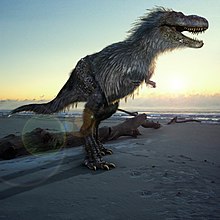Gorgosaurus
Gorgosaurus (Greek: "impetuous lizard", from γοργός gorgos "impetuous, terrible" and σαῦρος sauros "lizard") was a theropod dinosaur of the family Tyrannosauridae that lived about 76 to 72 million years ago in the Upper Cretaceous (late Campanian) in western North America. Fossil remains have been discovered in the Canadian province of Alberta and possibly in the US state of Montana. Currently, only one species of this genus is recognized, the type species Gorgosaurus libratus.
Like most known tyrannosaurids, Gorgosaurus was a bipedal carnivore that weighed more than a ton as an adult and bore dozens of large, sharp teeth in its jaws, while its two-fingered arms were small in proportion. Gorgosaurus was closely related to the very similar Albertosaurus; the two genera are separated only by minor differences in teeth and skull bones. Some experts consider Gorgosaurus libratus to be a species of Albertosaurus - according to this view, Gorgosaurus would be a juvenile synonym of this genus.
Gorgosaurus lived in a lush floodplain along the Western Interior Seaway, an estuary that bisected North America during the Upper Cretaceous. As an apex predator, Gorgosaurus was at the top of the food chain and probably hunted the common ceratopsids and hadrosaurids. In some areas, Gorgosaurus lived with Daspletosaurus, another tyrannosaurid. Although these animals were about the same size, there is evidence that the two genera occupied different ecological niches. Gorgosaurus is the most commonly found tyrannosaurid - the numerous fossils allow scientists to draw conclusions about tyrannosaurid biology, such as individual development (ontogeny).
Description
Gorgosaurus reached about the size of Albertosaurus and Daspletosaurus. Adult animals grew to between eight and nine meters long and probably weighed more than 2.4 tons. The largest skull found measured 99 centimeters in length, only slightly smaller than that of Daspletosaurus, a tyrannosaurid that lived in the same area at the same time. As with other tyrannosaurids, the skull was large in proportion to the body, with chambers in the skull bones and large skull openings (cranial windows) reducing its weight. Albertosaurus and Gorgosaurus had proportionally longer and flatter skulls than Daspletosaurus and other tyrannosaurids. The end of the snout was blunt and the paired nasal bone (nasale) and paired parietal bone (parietale) were fused, along the midline of the skull, as in all other members of the family. The orbit (orbital window) was round, differing from the oval to keyhole-like shapes in other tyrannosaurids. Similar to Albertosaurus and Daspletosaurus, a high ridge of lacrimal bone extends in front of each eye. Gorgosaurus is distinguished from Albertosaurus by differences in the bones surrounding the brain.
The teeth of Gorgosaurus were typical of all known tyrannosaurids. The eight teeth of the premaxillary at the front end of the snout were small, densely packed, and "D"-shaped in cross-section compared to the rest of the teeth. The remaining teeth were oval in cross-section, rather than blade-shaped as in most other theropods. In addition to the eight teeth of the premaxilla, Gorgosaurus had 26 to 30 teeth in the maxilla and 30 to 34 teeth in the mandible. Gorgosaurus thus has about as many teeth as Albertosaurus and Daspletosaurus, but fewer than Tarbosaurus or Tyrannosaurus.
As with all tyrannosaurids, Gorgosaurus' build plan is characterized by a large head sitting on an "S" shaped neck. In contrast to the large head, the arms were very small. The hands had only two fingers and claws, although a third limb in the metacarpus has been demonstrated in some finds - a rudiment of the third finger as possessed by other theropods. The hind legs of tyrannosaurids were longer in relation to the body than in other theropods. The longest femur known from Gorgosaurus measured 105 centimeters. However, in several smaller specimens, the tibia was longer than the femur - a ratio often found in fast-running animals. The two bones were about the same length in the largest skeletons found.
After the initial description of Yutyrannus in 2012, a large and very closely related species that was fully feathered, it is certain that Gorgosaurus was also clothed in a soft fluff of down feathers.

Gorgosaurus in size comparison with a human being
Systematics
Within the Tyrannosauridae, Gorgosaurus is included in the subfamily Albertosaurinae - along with the closely related, geologically somewhat younger Albertosaurus. These two genera are the only definitive representatives of the Albertosaurinae that have been described so far - although there may be other undescribed genera. All other tyrannosaurids are classified in the second subfamily, the Tyrannosaurinae. Compared to the tyrannosaurines, albertosaurines are characterized by a slimmer build with proportionally smaller, flatter skulls and longer lower leg and foot bones.
The distinct similarities between Gorgosaurus libratus and Albertosaurus sarcophagus led many experts to suggest that the two genera should be united - thus Gorgosaurus was sometimes recognized as a juvenile synonym of Albertosaurus. Albertosaurus was named before Gorgosaurus, and thus would be the valid name if they were one and the same genus. Paleontologists William Diller Matthew and Barnum Brown doubted the distinction between two genera as early as 1922, and Gorgosaurus libratus was formally reassigned to Albertosaurus (as Albertosaurus libratus) by Dale Russell (1970), and many authors followed this assumption. If Gorgosaurus were indeed a subspecies of Albertosaurus, this would greatly expand the geographic and chronological distribution of the latter. Other experts distinguish between the two genera. For example, Canadian paleontologist Philip J. Currie notes that there are as many anatomical differences between Albertosaurus and Gorgosaurus as there are between Daspletosaurus and Tyrannosaurus, which are almost always listed as independent genera. He further notes that as yet undescribed tyrannosaurids from Alaska, New Mexico, and other sites in North America may help clarify the situation.

Live reconstruction of Gorgosaurus with feather-like skin appendages
Search within the encyclopedia